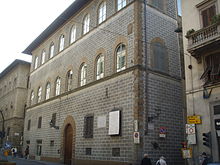Bardi family
| Bardi | |
|---|---|
 | |
| Country | |
| Place of origin | Tuscany, Italy |
| Founded | 10th century |
| Final ruler | Pier Maria de' Bardi |
| Titles | Count of Vernio |
| Dissolution | 1810 |
The House of Bardi was an influential
History

The nobility of the Bardi family has been documented since the year 1164, when Emperor
In the 1290s, the Bardi and Peruzzi families had established branches in England and were the main European bankers by the 1320s. By the fourteenth century the Bardi and the Peruzzi family grew tremendously wealthy by offering financial services.[3] These two families facilitated trade by providing the merchants with bills of exchange, known today as checks. What made it so simple was that money paid by a debtor in one town could be paid out to creditor just by presenting the bill in another town.[4][3] By 1338, there were more than eighty banking houses in Florence.
During the
Despite the failure of the bank, the Bardi family ranked among
Besides banking, the Bardi family were "great patrons of the friars."
Two important paintings, both called the
See also
References
- ^ Guidi-Bruscoli 2012.
- ^ a b c Pernis & Schneider Adams 2006, pp. 10–11.
- ^ a b c Banking in the Middle Ages.
- ^ a b c d History of Banking.
- ^ Tomas 2003, p. 16-17.
- ^ a b Tomas 2003, p. 17.
- ^ a b Cook 2005, p. [page needed].
Bibliography
- "Banking in the Middle Ages". End of Europe's Middle Ages. Applied History Research Group / University of Calgary. 1997. Archived from the original on 2013-12-25. Retrieved 16 Dec 2013.
- Cook, William R. (2005). The Art of the Franciscan Order in Italy. Brill Academic Publications. ISBN 9789004131675.
- Guidi-Bruscoli, F. (2012). "John Cabot and his Italian financiers*". Historical Research. 85 (229): 372–393. .
- "History of Banking – Religion and Banking: 12th-13th Century". www.historyworld.net.
- Pernis, Maria Grazia; Schneider Adams, Laurie (2006). Lucrezia Tornabuoni De' Medici and the Medici Family in the Fifteenth Century. New York: Peter Lang Publishing.
- Romaniello, Matthew P. (2008). "Lucrezia Tornabuoni de' Medici and the Medici Family in the Fifteenth Century – by Maria Grazia Pernis and Laurie Schneider Adams". The Historian. 70 (2): 389. S2CID 144053996.
- Tomas, Natalie R. (2003). The Medici Women: Gender and Power in Renaissance Florence. Aldershot: Ashgate. ISBN 0754607771.
Further reading
- "Bardi Family", www.britannica.com
